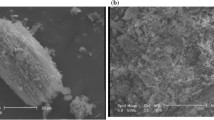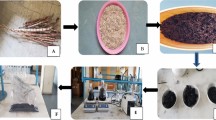Abstract
The main purpose of the present study is to investigate the efficiency of the biomass waste, which is represented by grape leaf waste, for the adsorption of methylene blue textile dye from an aqueous solution after chemical treatment with phosphoric acid. The synthesized activated carbon acid-GL has been characterized using FTIR, SEM, and BET to realize the possibility of the surface for the purpose of the study. The removal of methylene blue from the aqueous medium is studied parametrically using parameters like pH solution, amount of adsorbent, MB levels, volume solution, and temperature. However, the investigation of the parameters has been provided using response surface methodology to see which factors are significant and have a strong effect on the removal of dye. The adsorption profile has followed the Langmuir model with a correlation factor (R2 = 0.9766), which indicates that it fits the experimental data from the other isotherm, like Freundlich (R2 = 0.948). Methylene blue (MB) has a maximum adsorption capacity of 28.85 mg/g on acid-GL at 20 °C and pH 7. The model of pseudo-second order provides a satisfactory fitting rate equation (R2 = 0.998) compared to other kinetics models, according to the kinetics analysis of the MB adsorption. Overall, the results suggest using grape leaves as an inexpensive, environmentally friendly adsorbent to remove basic (cationic) textile dye (MB) from water. Utilizing experimental data, RSM was able to accurately forecast the removal percentage under ideal circumstances.






Similar content being viewed by others
Data availability
The dataset utilized/analyzed during the current study will be available from the corresponding author upon request.
References
Boudechiche N, Fares M, Ouyahia S, Yazid H, Trari MSZ (2019) Comparative study on removal of two basic dyes in aqueous medium by adsorption using activated carbon from Ziziphus lotus stones. Microchem J 146:1010–1018
Draper B, Yee WL, Pedrana A et al (2022) Reducing liver disease-related deaths in the Asia-Pacific: the important role of decentralised and non-specialist led hepatitis C treatment for cirrhotic patients. Lancet Reg Heal Pacific. https://doi.org/10.1016/j.lanwpc.2021.100359
Zhou Y, Lu J, Zhou Y, Liu Y (2019) Recent advances for dyes removal using novel adsorbents: a review. Environ Pollut 252:352–365
Stewart GG (2016) Saccharomyces species in the production of beer. Beverages 2:34
Moghaddam SS, Moghaddam MRA, Arami M (2010) Coagulation/flocculation process for dye removal using sludge from water treatment plant: optimization through response surface methodology. J Hazard Mater 175:651–657
Chaari I, Fakhfakh E, Medhioub M, Jamoussi F (2019) Comparative study on adsorption of cationic and anionic dyes by smectite rich natural clays. J Mol Struct 1179:672–677
Bazzo A, Adebayo MA, Dias SLP et al (2016) Avocado seed powder: characterization and its application for crystal violet dye removal from aqueous solutions. Desalin water Treat 57:15873–15888
Shetti NP, Malode SJ, Malladi RS et al (2019) Electrochemical detection and degradation of textile dye congo red at graphene oxide modified electrode. Microchem J 146:387–392
Kausar A, Iqbal M, Javed A et al (2018) Dyes adsorption using clay and modified clay: a review. J Mol Liq 256:395–407
Murthy TPK, Gowrishankar BS, Prabha MNC et al (2019) Studies on batch adsorptive removal of malachite green from synthetic wastewater using acid treated coffee husk: equilibrium, kinetics and thermodynamic studies. Microchem J 146:192–201
Mohebali S, Bastani D, Shayesteh H (2019) Equilibrium, kinetic and thermodynamic studies of a low-cost biosorbent for the removal of Congo red dye: Acid and CTAB-acid modified celery (Apium graveolens). J Mol Struct 1176:181–193
Mashkoor F, Nasar A (2019) Preparation, characterization and adsorption studies of the chemically modified Luffa aegyptica peel as a potential adsorbent for the removal of malachite green from aqueous solution. J Mol Liq 274:315–327
Chakraborty S, Chowdhury S, Das SP (2011) Adsorption of crystal violet from aqueous solution onto NaOH-modified rice husk. Carbohydr Polym 86:1533–1541
Al-Asadi ST, Al-Qaim FF, Al-Saedi HFS et al (2023) Adsorption of methylene blue dye from aqueous solution using low-cost adsorbent: kinetic, isotherm adsorption, and thermodynamic studies. Environ Monit Assess 195:676
Bailey SE, Olin TJ, Bricka RM, Adrian DD (1999) A review of potentially low-cost sorbents for heavy metals. Water Res 33:2469–2479
Seidmohammadi A, Asgari G, Leili M et al (2015) Effectiveness of quercus branti activated carbon in removal of methylene blue from aqueous solutions. Arch Hyg Sci 4:217–225
Robinson T, Chandran B, Nigam P (2002) Effect of pretreatments of three waste residues, wheat straw, corncobs and barley husks on dye adsorption. Bioresour Technol 85:119–124
Hameed KS, Muthirulan P, Sundaram MM (2017) Adsorption of chromotrope dye onto activated carbons obtained from the seeds of various plants: equilibrium and kinetics studies. Arab J Chem 10:S2225–S2233
Hameed BH, Daud FBM (2008) Adsorption studies of basic dye on activated carbon derived from agricultural waste: Hevea brasiliensis seed coat. Chem Eng J 139:48–55
Kumar KV, Kumaran A (2005) Removal of methylene blue by mango seed kernel powder. Biochem Eng J 27:83–93
Ozdemir I, Şahin M, Orhan R, Erdem M (2014) Preparation and characterization of activated carbon from grape stalk by zinc chloride activation. Fuel Process Technol 125:200–206
Al-Qaim FF, Mussa ZH, Yuzir A et al (2018) Full factorial experimental design for carbamazepine removal using electrochemical process: a case study of scheming the pathway degradation. J Braz Chem Soc. https://doi.org/10.21577/0103-5053.20180047
Jawad AH, Alkarkhi AFM, Mubarak NSA (2015) Photocatalytic decolorization of methylene blue by an immobilized TiO2 film under visible light irradiation: optimization using response surface methodology (RSM). Desalin Water Treat 56:161–172
Prola LDT, Acayanka E, Lima EC et al (2013) Comparison of Jatropha curcas shells in natural form and treated by non-thermal plasma as biosorbents for removal of reactive red 120 textile dye from aqueous solution. Ind Crops Prod 46:328–340
Tran HN, You S-J, Nguyen TV, Chao H-P (2017) Insight into the adsorption mechanism of cationic dye onto biosorbents derived from agricultural wastes. Chem Eng Commun 204:1020–1036
Guo D, Li Y, Cui B et al (2020) Natural adsorption of methylene blue by waste fallen leaves of Magnoliaceae and its repeated thermal regeneration for reuse. J Clean Prod 267:121903
Jawad AH, Ramlah AR, Khudzir I, Sabar S (2017) High surface area mesoporous activated carbon developed from coconut leaf by chemical activation with H3PO4 for adsorption of methylene blue. Desalin Water Treat 74:326–335
Kushwaha AK, Gupta N, Chattopadhyaya MC (2014) Removal of cationic methylene blue and malachite green dyes from aqueous solution by waste materials of Daucus carota. J Saudi Chem Soc 18:200–207
De Marco C, Mauler RS, Daitx TS et al (2020) Removal of malachite green dye from aqueous solutions by a magnetic adsorbent. Sep Sci Technol 55:1089–1101
Izan NR, Zainol MM, Nordin AH et al (2022) Removal of methylene blue via adsorption using magnetic char derived from food waste. Malaysian J Chem 24:283–292
Shoukat S, Bhatti HN, Iqbal M, Noreen S (2017) Mango stone biocomposite preparation and application for crystal violet adsorption: a mechanistic study. Microporous Mesoporous Mater 239:180–189
Konicki W, Cendrowski K, Bazarko G, Mijowska E (2015) Study on efficient removal of anionic, cationic and nonionic dyes from aqueous solutions by means of mesoporous carbon nanospheres with empty cavity. Chem Eng Res Des 94:242–253
Ahmad R, Kumar R (2010) Adsorption studies of hazardous malachite green onto treated ginger waste. J Environ Manage 91:1032–1038
Bharathi KS, Ramesh ST (2013) Removal of dyes using agricultural waste as low-cost adsorbents: a review. Appl Water Sci 3:773–790
Hu X-S, Liang R, Sun G (2018) Super-adsorbent hydrogel for removal of methylene blue dye from aqueous solution. J Mater Chem A 6:17612–17624
Ho Y-S, McKay G (1998) Sorption of dye from aqueous solution by peat. Chem Eng J 70:115–124
Ho Y-S, McKay G (1999) Pseudo-second order model for sorption processes. Process Biochem 34:451–465
Weber WJ Jr, Morris JC (1963) Kinetics of adsorption on carbon from solution. J Sanit Eng Div 89:31–59
Langmuir I (1918) The adsorption of gases on plane surfaces of glass, mica and platinum. J Am Chem Soc 40:1361–1403
Khaled A, El Nemr A, El-Sikaily A, Abdelwahab O (2009) Treatment of artificial textile dye effluent containing direct yellow 12 by orange peel carbon. Desalination 238:210–232
Mousavi SA, Mahmoudi A, Amiri S et al (2022) Methylene blue removal using grape leaves waste: optimization and modeling. Appl Water Sci 12:1–11
Mekuria D, Diro A, Melak F, Asere TG (2022) Adsorptive removal of methylene blue dye using biowaste materials: barley Bran and Enset midrib leaf. J Chem. https://doi.org/10.1155/2022/4849758
Martín-González MA, Susial P, Pérez-Peña J, Doña-Rodríguez JM (2013) Preparation of activated carbons from banana leaves by chemical activation with phosphoric acid. Adsorption of methylene blue. Rev Mex Ing química 12:595–608
Mahamad MN, Zaini MAA, Zakaria ZA (2015) Preparation and characterization of activated carbon from pineapple waste biomass for dye removal. Int Biodeterior Biodegrad 102:274–280
Tran HN, You S-J, Chao H-P (2017) Fast and efficient adsorption of methylene green 5 on activated carbon prepared from new chemical activation method. J Environ Manage 188:322–336
Acknowledgements
Many thanks to university of Babylon for the support.
Funding
No funding was obtained for this study.
Author information
Authors and Affiliations
Corresponding author
Ethics declarations
Competing interest
The authors declare that they have no conflict of interest.
Ethical approval
All authors have read, understood, and have complied as applicable with the statement on “Ethical responsibilities of Authors” as found in the Instructions for Authors.
Additional information
Publisher's Note
Springer Nature remains neutral with regard to jurisdictional claims in published maps and institutional affiliations.
Supplementary Information
Below is the link to the electronic supplementary material.
Rights and permissions
Springer Nature or its licensor (e.g. a society or other partner) holds exclusive rights to this article under a publishing agreement with the author(s) or other rightsholder(s); author self-archiving of the accepted manuscript version of this article is solely governed by the terms of such publishing agreement and applicable law.
About this article
Cite this article
Al-Qaim, F.F., Al-Saedi, H.F.S., Mussa, Z.H. et al. Application of the response surface approach to the adsorption of methylene blue from water using acid-modified grape leaves. Reac Kinet Mech Cat 137, 399–422 (2024). https://doi.org/10.1007/s11144-023-02542-5
Received:
Accepted:
Published:
Issue Date:
DOI: https://doi.org/10.1007/s11144-023-02542-5




